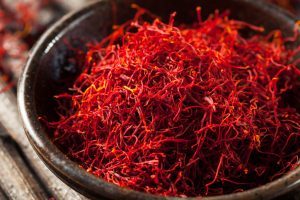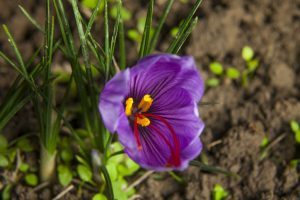
By: Cat Ebeling, BSN,co-author of the best-sellers: The Fat Burning Kitchen,The Top 101 Foods that Fight Aging&The Diabetes Fix
Did you know that saffron is considered the most expensive spice in the world?
Saffron has uniquely beautiful, exotic and healthful properties that make any dish amazingly delicious and good for your health. Saffron also, like many spices, boasts some pretty powerful medicinal properties as well. In ancient Egypt, it was used for gastrointestinal disorders, and in Roman days it was used for wounds and to relieve upper respiratory issues.
Saffron also has cancer-fighting, anti-inflammatory substances and has been put to use for a wide variety of treatments including coughs, colds, spasms, fevers, bronchitis, uterine bleeding, flatulence, and insomnia.
It’s also used for coughs as an expectorant, and it helps lessen asthma symptoms. In ancient Mediterranean cultures, the spice was also associated with strength, fertility, psychic sensitivity and sexual potency.
Saffron has been grown all over Europe, Greece, Spain, Turkey, France and Italy as well as India and China. Its high price tag is mostly due to the fact that it is very labor intensive to grow, has a low yield per plant, and is difficult to harvest. It actually takes about 4,500 hand-picked flowers to yield one ounce of this dried spice. Only three wispy ‘threads’ come from each saffron flower, which is a member of the iris family.
But beware of fake saffron. The high cost of genuine saffron makes it easy to end up with fake saffron, so read labels carefully and purchase from a reliable supplier. Also watch out for something called “meadow saffron” which can be very toxic and is quite different than genuine saffron.

Saffron is also well-known as a dye, as only a single grain can color up to 10 gallons of water with its signature yellow-orange hue. Precious saffron colors the robes of Buddhist monks in India.
While it would be hard to eat a whole ounce of saffron, this is a good way to evaluate its nutrition. It is super high in manganese which helps to regulate blood sugar, metabolize carbohydrates, and absorb calcium. It’s also very high in vitamin C, magnesium, and iron. But you don’t have to eat a whole ounce of saffron for its health benefits!
More importantly, like many herbs and spices, saffron contains more than 150 unique volatile compounds. One of them, picrocrocin, is the main substance behind its taste. Another substance, safranal is responsible for its fragrant smell. Crocin is another compound in saffron and has much to do with its intense color. Crocin signals that it contains powerful carotenoids and antioxidants and other medicinal attributes.
Let’s take a look at some of the top health benefits of saffron.
Fights Cancer

Saffron extract has been studied scientifically and is shown to have anti-tumor effects. In addition, topical applications of saffron extract have proven effective against stage 2 skin cancer, and taking it orally has shown to slow cancer cells in soft tissue and inhibit tumor growth in mice. Other studies show that saffron helps to reduce the negative side effects of toxic chemotherapy treatments.
In another clinical trial the effects of saffron for treating patients with liver cancer was studied. In the group treated with saffron, two patients showed partial and complete response (50%) whereas in the placebo group, no response was seen.
Treats Erectile Dysfunction
Erectile Dysfunction (ED) is becoming a very common malady, especially among older males. It affects over 150 million males throughout the world. In ancient medicine, saffron has been used as an aphrodisiac, so it makes sense that it would also work well for ED.
In a study evaluating saffron’s on ED, 20 males took a tablet containing 200mg of the spice. At the end of ten days, there was a statistically significant improvement in erections, including a positive effect on sexual function with increased duration and events.
Heart Health

Components of saffron are also extremely valuable at improving heart heath as well. Saffron has been reported to help lower bad cholesterol and to help keep cholesterol levels in the healthy ranges. Animal studies show saffron to lower cholesterol by as much as 50%.
Saffron has antioxidant properties, which helps it maintain healthy blood vessels. In addition, saffron has strong anti-inflammatory properties as well, which also helps to lower inflammation in blood vessels, reducing the chances for blood clots, heart attacks, and strokes.
In the Mediterranean, where saffron use is plentiful, people have lower than normal rates of heart disease, which may be attributed to a variety of diet and lifestyle factors, including saffron use.
Helps Premenstrual Syndrome
Premenstrual syndrome (PMS) is associated with bloating, cramping, and mood changes. PMS affects 20-40% of women who are of reproductive age, making PMS one of the most common health problems reported by women.
One of saffron’s capabilities is its antispasmodic effect. In this study on saffron and PMS, women aged 20-45 were recruited to participate for six months. Results showed a significant improvement in both daily physical symptoms of PMS along with the depressive symptoms, as compared to the placebo group.
Helps with Weight Loss and Glucose Control

One of the biggest difficulties to overcome on a weight loss program is feeling hungry and having cravings. Snacking has derailed many weight loss plans.
Saffron has been shown to be effective at increasing satiety and taking away hunger for those on a weight loss program. One research study based in Malaysia, evaluated women on a weight loss program, who took a capsule with saffron extract in it vs. a placebo group. After two months in the study, participants using saffron reported a decrease in their cravings and snacking and lost more weight than the control group.
Saffron can also help to reduce blood glucose levels and increase insulin response, which is especially helpful for diabetics. The substance crocin in saffron was found to have anti-diabetic properties in diabetic rats fed fructose.
High blood sugar also results in Advanced Glycation End products (AGE’s). These AGE’s are responsible for excessive oxidation and inflammation which can exacerbate inflammation in blood vessels of diabetics, a key area of vulnerability. Crocin helps to lower inflammation and protect blood vessels, thereby helping to prevent the health complications that many diabetics manifest.
Treats Depression as well as Some Antidepressants
Depression is an increasingly prevalent mental disorder today, with growing numbers. Depression can affect people of all ages. The Centers for Disease Control find that 1 out of 10 adults in the U.S. suffer from depression. By 2020, it is thought that depression will be the world’s second leading cause of disability.
It is thought that one theory of depression has to do with inflammation in the brain, so many treatments aim to lower inflammation, overall.
In the past 25 years, however, the use of antidepressant medications has gone up over 400%, with 11% of Americans taking antidepressants. One of the biggest problems with prescription antidepressants is the extreme number of severe side effects (up to 90% of patients) including anxiety, constipation, insomnia, weight gain, sexual dysfunction, and even suicide.
Saffron has a long history of being used to treat depression, so it was scientifically studied to determine its effectiveness. Scientists conducted a six-week study on 40 patients who were officially diagnosed as suffering from major depression.
One group was given a saffron capsule twice a day for six weeks. The other group was given a placebo. The saffron subjects showed significantly better outcomes than the placebo group, without the adverse reactions that patients on antidepressant medication have.
The conclusion: Saffron was as effective as Prozac and other antidepressants without the side effects—especially sexual dysfunction. Saffron has also been shown to be highly effective in reducing anxiety as well.
Possible Side Effects of Saffron

Saffron has such powerful medicinal effects, it needs to be taken with caution, especially when combining it with any other herbal or medicinal supplements that lower blood pressure.
Some supplements to avoid include: Andrographis, casein peptides, cat’s claw, fish oil, CoQ10, L-arginine, stinging nettle, lyceum and theanine. Saffron can also cause severe asthma or nasal stuffiness if you happen to be allergic to it.
Consuming too much saffron can cause saffron poisoning resulting in:
-yellowing of the skin and eyes
-vertigo
-vomiting
-bloody diarrhea
-bloody urine
-bleeding from the nose, mouth, eyes
Do not consume saffron or take saffron supplements if you are pregnant, as large amounts (5-10 grams) can actually induce miscarriages.
How to Use Saffron
While saffron is very expensive, you don’t need much of this rare spice to impart a delicious flavor and color to your dishes. Saffron threads come from the long slender part at the center of the saffron flower, the stigma. The herb comes either whole in threads or ground into a powder. The threads usually have the highest quality flavor.
Saffron gives your dishes a spicy, pungent and slightly bitter flavor. It is perfect in rice dishes and goes with many Mediterranean recipes like seafood paella, risotto, or Indian saffron rice and adds a bright appetizing yellow color. It works well with many vegetables, meats, seafood and poultry. Saffron is available from many specialty markets or gourmet grocery stores.
Here are a couple of delicious recipes I found online.
Saffron Recipes
- Enjoy a bowl of Saffron Ginger Carrot Soup.
- Yummy dinner– Saffron Meyer Lemon Roasted Chicken.
- Delicous dessert Persian Saffron Pudding.
References
https://draxe.com/saffron/
https://www.lifeextension.com/Magazine/2013/7/A-Safer-Alternative-for-Managing-Depression/Page-01
https://foodfacts.mercola.com/saffron.html
 thenutritionwatchdog.com What's in your food? Discover which "healthy" foods are harming your health and which foods protect your body
thenutritionwatchdog.com What's in your food? Discover which "healthy" foods are harming your health and which foods protect your body